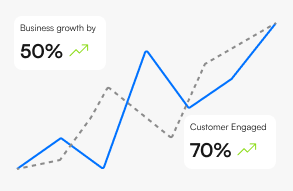Customer experience automation: Four pillars (+ free ai chatbot builder)

Kumar Shubham
August 21, 2024
11 min

Table of Contents
Remember when you had a seamless, personalized interaction with a company? Chances are, there was some clever tech working behind the scenes. Welcome to the world of customer experience automation!
As per McKinsey, successful CX automation can cut costs by 40% while boosting satisfaction.
Gone are the days when automation meant clunky chatbots and frustrating phone menus. Today, customer relationship management is about smart systems that anticipate your needs, solve problems in real-time, and maybe even crack a joke or two along the way.
But here’s the kicker: great customer experience automation isn’t about replacing humans. It’s about enhancing what we do best. Think of it as giving your support team superpowers, allowing them to focus on complex issues while AI handles routine customer data.
What is Customer Experience Automation?
Customer Experience Automation (CXA) is the strategic use of technology, powered by AI and machine learning, to streamline and personalize customer interactions across various touchpoints.
From proactive support to tailored recommendations, CXA ensures every engagement is relevant and timely. It’s not just about improving efficiency; it’s about customer service excellence; it’s about enhancing every software category and transforming the entire customer journey into a cohesive, meaningful experience.
- Email marketing: You can automatically adjust email content based on individual purchase history. e-commerce and marketing automation: You can trigger personalized social media ads based on recent website interactions.
- CRM: Automatically prioritize leads based on real-time engagement scores.
- Account management: Instantly alert account managers to potential churn risks based on support ticket patterns.
Curious about how this magic happens so you can meet customer expectations? Or maybe you’re just trying to figure out how to implement customer experience automation without causing a digital meltdown?
In this article, learn more about how customer experience automation is changing the way customer engagement happens in real-time.
Four Pillars of Customer Experience Automation
Customer Experience Automation (CXA) uses technology to streamline customer journeys and enhance customer interactions across various touchpoints. Key components include:

1. Orchestration
This is about making your customer’s experience smooth. Say a customer starts a chat on your website about a problem with their order. Later, they call your support line. Orchestration ensures the phone agent can access the earlier chat history. This way, the customer doesn’t have to repeat information, and each interaction builds on the last. Orchestration and strong omnichannel strategies retain 89% of customers vs 33% for weak ones. Better workflows make your entire company function as one cohesive unit so you can retain most of your existing customers.
2. Segmentation and analysis
Segmentation is about understanding and grouping your customers based on shared characteristics or behaviors. It’s like organizing a massive library so you can quickly find the right book. By analyzing data from purchases, website clicks, support interactions, and more, you can identify patterns. For example, you might notice that customers who buy running shoes often purchase socks within a month. This insight allows you to create targeted marketing campaigns or personalized product recommendations for specific customer segments.
3. Personalization
Forbes found that 91% of consumers prefer brands offering relevant recommendations. This is why you need to tailor experiences for each customer. Personalization is like having a super-attentive sales associate for every single customer. If someone always buys XL t-shirts, your website might start showing XL sizes first. Or if a customer usually calls for tech support late at night, you might offer them 24/7 chat support.
4. Automation and AI
Automation tools are the brain of your system. It takes all that data and uses it to make smart decisions. Let’s say a customer types a question into your chatbot. The AI (Artificial Intelligence features) enable it to figure out what they’re asking, even if they use slang or make typos. It then picks the best answer based on what’s worked well for similar customers in the past. The cool part? It gets better over time, learning from every conversation. Learn more about conversational and generative AI.
When you put all these pieces together, you get a system that can handle tons of customer interactions while still feeling personal and helpful. It’s like scaling up great customer service without losing the human touch. Overall, you receive better customer feedback and build long-term customer relationships.
Why Automating your Customer Experience is no Longer Optional
According to PWC, 32% of customers would leave a loved brand after one bad experience. So, you need to optimize every experience.
- Resource Optimization: Small teams can handle a larger volume of customer interactions efficiently.
- Global Reach: Automated systems can overcome language barriers and cultural nuances, serving customers worldwide without requiring extensive multinational support teams.
- Consistency: Automated responses ensure a uniform quality of interaction across all customer touchpoints.
- 24/7 Availability: Automated systems provide round-the-clock support without the limitations of human work hours.
- Scalability: As businesses grow, automated systems can easily scale to meet increasing customer communication demands without proportional increases in cost.
Benefits of customer experience automation

- Better response times: You can provide instant responses, reduce customer wait times, and still achieve high levels of accuracy. For example, Thinkstack has reported 70% accuracy in responses, surpassing standards set by human-powered chat experiences.
- Continuous improvement: Automated systems can learn from each interaction, constantly refining their responses and improving the overall customer experience. This process involves:
- Analyzing the quality of each response
- Identifying patterns in successful interactions
- Updating the knowledge base and response algorithms
- Adapting to new customer needs and preferences
- Cost-effective: While initial setup may require investment, automated systems can significantly reduce long-term operational costs associated with customer support.
- Reduced human error: Automation minimizes the risk of human errors in repetitive tasks, ensuring consistent quality in customer interactions.
In fact, Deloitte says that customer-centric companies are 60% more profitable. Through Customer Experience Automation, you can optimize their resources and provide better, more efficient, and personalized experiences. Check out this blog on the benefits of chatbots.
Designing your Customer Experience Automation System with ThinkStack
Not every customer of yours will be happy to talk to a chatbot. That’s why you need both humans and technology.
This is why Thinkstack combines machine learning with human support. Their system uses advanced sentiment analysis to assess customer emotions during interactions, enabling more appropriate responses. When negative emotions are detected, the system offers an option to speak with a human agent, ensuring complex issues receive personal attention.
This high-quality hybrid approach allows operational efficiency so businesses can handle routine inquiries while providing human interaction for sensitive situations.
Ready to see how this works in reality?
With Thinkstack, you’re just four steps away from your very own digital helper:
- Upload your data: Feed your bot some knowledge. Just upload the files you want it to learn from. Don't worry, Thinkstack keeps everything secure.
- Train your bot: Pick what you want your bot to focus on. It's like creating a crash course for your digital assistant.

- Customize settings: Tweak how your bot behaves. Set how often it checks in and how deep it digs into data. Make it work the way you want.

- Launch and go: That's it! Your bot is ready to tackle tasks, analyze data, and chat with customers.


And there you have it - your very own chatbot. Ready to give it a shot?
Three Proven Strategies for Customer Experience Automation Implementation
Want to make your customer experience work? Here are some smart moves to make when you’re setting up your automation:
- Intelligent content delivery: This is about getting the right info to your customers at just the right time. Imagine your website knowing exactly what product guide to show based on what's in a customer's cart. Or your app sends a how-to video right when a customer gets stuck.
- Predictive customer insights: Data can help you predict what your customers might need next. Say someone buys a printer. Your system might predict they'll need ink soon and send a reminder before they run out. It's not magic, just smart use of patterns in customer behavior.
- 24/7 engagement and support: It's about being there for every customer query, anytime, anywhere. With chatbots and automated systems, you can answer questions, process returns, or even help with troubleshooting in the middle of the night. No more "Sorry, we're closed" messages!
Measuring the Success of Customer Experience Automation
So, you’ve got everything set up. But how do you know if it’s working? Here’s what can help you:
- Key Performance Indicators (KPIs)
The report card for customer happiness. The list includes:- Response time: How quickly are you getting back to customers? If your chatbot is firing off quality answers in seconds instead of minutes, you're on the right track.
- First contact resolution: Are you solving problems in one go? If customers aren't repeatedly asking the same question, your automation is doing its job.
- Customer effort score: Here you check the ease with which your customers got what they needed.
- Engagement metrics
This is to check if customers like interacting with your automated systems. The list includes:- Chatbot usage: Are people using your chatbot, or are they desperately hunting for a human to talk to?
- Customer satisfaction scores: Simply ask customers, "How'd we do?" after each interaction. If your scores are going up, you're on the right path.
- Net Promoter Score (NPS): This tells you if customers like you enough to recommend you to friends. A rising NPS is a great sign your automation is winning hearts.
Remember, the goal isn’t just to have cool tech - it’s to make your customers’ lives easier and keep them coming back for more. You’re not just automating, you’re improving your customer experience. Learn more about chatbot analytics.
Three Takeaways
To wrap up, here are three takeaways to help you:
- Balance is key: Let the bots handle the routine stuff, while your team tackles the complex issues.
- Personalization matters: Use data intelligently to tailor experiences. From product recommendations to support options, make every customer feel like your only customer.
- Measure and improve: Track KPIs, engagement metrics, and satisfaction scores. They'll tell you if you're on the right track and where you can do even better.
Ready to Build Better Customer Experiences?
Don’t just read about customer experience automation—discover and experience an AI-powered chatbot for your entire customer lifecycle! Try ThinkStack’s AI chatbot builder for FREE.
- Set up in minutes. No coding required.
- Customizable to your needs
- Secure data handling
Frequently Asked Questions (FAQs)

Grow Your Business with AI Chatbots
-
Automate tasks
-
Engage customers 24/7
-
Boost conversions